Are you a Quiet Speculation member?
If not, now is a perfect time to join up! Our powerful tools, breaking-news analysis, and exclusive Discord channel will make sure you stay up to date and ahead of the curve.
Preparation means something unique to everyone, and each player has their own pre-tournament ritual. Mine tends to vary depending on how invested I am in the format, and what other stuff I have going on. The SCG Roanoke Invitational will be underway by the time this piece goes public. In this article, I’ll describe how I prepared for that dual-format event, and reveal what I learned along the way about setting goals and relaxing expectations.
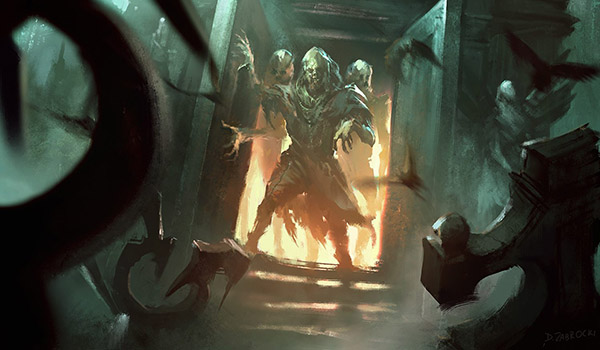
Motivation and Level Calibration
I’ve worked hard on preparing for the Invitational ever since Star City Games let me know I was qualified a month ago. “Hard,” of course, is relative, and what’s hard for me might not be what’s hard for you. In truth, preparing for this tournament has shown me that I’m not as serious a player I once thought I was. Part of my preparation has in fact consisted of coming to terms with that realization.
A couple years ago, when prompted about my Magic aspirations, I would reply that I wanted to make the Pro Tour. Not to win it, necessarily, but to compete at the game’s highest level. At the time, I would occasionally go to Competitive REL events, and greatly enjoyed the competition I found there. In the meantime, I brought silly brews to FNMs and tolerated the low quality of my opponents.
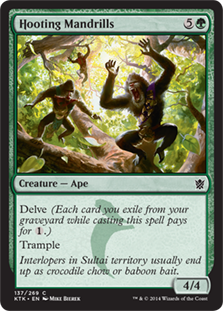 When I talked to Josh Utter-Leyton, a player I respect immensely, about this aspiration at GP Charlotte in 2015, he told me I could make the Pro Tour if I wanted to—whether I did or not depended on how much grinding I was prepared to do. His comments went over my head. Here I was doing well at what I considered a high-level tournament with Temur Delver, a deck I’d created myself and recently won a Classic with (my most significant Magic achievement to this day). If anyone can make it, I thought to myself, I should have no problem.
When I talked to Josh Utter-Leyton, a player I respect immensely, about this aspiration at GP Charlotte in 2015, he told me I could make the Pro Tour if I wanted to—whether I did or not depended on how much grinding I was prepared to do. His comments went over my head. Here I was doing well at what I considered a high-level tournament with Temur Delver, a deck I’d created myself and recently won a Classic with (my most significant Magic achievement to this day). If anyone can make it, I thought to myself, I should have no problem.
It turns out Josh’s advice was spot-on, and I paid for not taking it to heart. In failing to prepare for GP Detroit (where I hadn't even made Day 2) and the RPTQ (where I'd made the ultimate rookie mistake of playing something I hadn’t tested in that metagame), I demonstrated to myself that I may not care enough about breaking into higher levels of competition to put in the hours Josh wisely identified as necessary. I meditated on these events over the last couple of weeks, which saw me grind out more games of Modern instead of committing to testing with Standard, or bring jokey decks to my local tournaments (including, of all things, an updated version of Banana Phone). Kelsey asked, if I wasn’t going to put in the work I’d need to win the tournament, why travel to the tournament at all?
Some marinating led me to this answer. I think this level of tournament is the one I really like playing in. GPs, Opens, Classics, and other medium-level Competitive REL Modern events have given me the most fun games of my career, as well as the most instructive. When I arrived to the RPTQ and proceeded to get stomped by players who had done their research, I understood at last that I wasn’t the best Magic player, even if I was the best at my humble LGS. There will always be someone smarter, or willing to do more work than me, a step above. Based on where I’m currently at with Magic, I think I want to be pushing at that level and aspiring to challenge those players with greater frequency. If doing so helps me improve (which it may), and I outgrow those players too, then I’ll have to reconsider my stance and think about committing more time to the game so I can continue competing at a level that stimulates me. I’m pretty sure the level I’ve decided to focus on is about as far up as I can go without having to dip into Standard and Limited, and I’d prefer to stick to Modern if possible; I just have way more fun here.
Despite my revelation that I actually don’t want to make the Pro Tour, I’m still stoked for the Invitational weekend, and excited to play the best Magic I can. Here’s what I’ll bring to battle in each format.
Standard: Mono-Black Zombies
I messed around with a few different Standard decks before settling on Zombies. I don’t want to dwell too much on the Standard metagame in this article (both because we’re Modern Nexus and because it just isn’t that interesting to me), but I think my experience of choosing a deck for a format I don’t play, specifically as someone who exclusively plays Modern, may interest some readers.
Mono-Black Zombies, by Gerry Thompson
I started testing for the Invitational just after the Aetherworks Marvel ban. Prior to that, I had no idea about the format, but was sure I would borrow Marvel from someone for the tournament. All I knew was that it was a swingy, fast, linear, infuriating deck that would likely give me some free wins. With Marvel out of the picture, I turned to the other Standard deck I’d at least heard about: Mardu Vehicles.
The Rejects
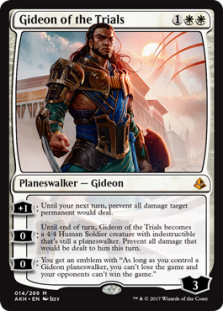 Vehicles is a highly interactive midrange deck with aggressive one-drops, recursive and evasive threats, and a respectable mid-game plan in Gideon, Ally of Zendikar. It also has the option of sideboarding into a planeswalker-centric control deck. In other words, Vehicles is a jack-of-all-trades full of stand-alone good cards, which is kind of what I enjoy playing in competitive events. I like to think that my skills in combat, sequencing, and pacing removal will translate smoothly between formats.
Vehicles is a highly interactive midrange deck with aggressive one-drops, recursive and evasive threats, and a respectable mid-game plan in Gideon, Ally of Zendikar. It also has the option of sideboarding into a planeswalker-centric control deck. In other words, Vehicles is a jack-of-all-trades full of stand-alone good cards, which is kind of what I enjoy playing in competitive events. I like to think that my skills in combat, sequencing, and pacing removal will translate smoothly between formats.
The pros seemed pretty down on the deck, with many citing Zombies and the various flavors of BG as superior choices. The consensus among them seemed to be that with Marvel gone, the decks that Marvel suppressed, and that are otherwise better than Vehicles, can rise up. I started to feel that Vehicles might be a strong choice since everything I read brushed it aside, as it might surprise players expecting the ostensibly stronger Zombies & co. Besides, it’s not like Vehicles is bad, by any means—it’s one of the few decks in Standard with passable one-drops and one of the few that properly wields the strongest card in Standard, Gideon, Ally of Zendikar.
Soon into my testing, though, I started having doubts. For one, the internet had no consistent opinion on the planeswalker plan for post-board games. I knew I would lose some matches to my own bad sideboarding, which I would prefer to avoid. Second, Mardu Vehicles is a deck that’s been around in Standard for what seems like forever at this point—after all, even I’d heard of the deck! Perhaps if the pros weren’t covering it as much, it wasn’t because the deck was necessarily a bad choice, but because everyone already knew plenty about it. Including how to beat it. My opponents were all guaranteed to have thought-out plans against me, whereas I was hoping to walk in and blindly turn guys sideways into the hate. Not to mention the possibility of a mirror-match: pairing with another Vehicles player almost guarantees that I lose, since they’ll have more experience in navigating the matchup and with sideboarding.
Next up was Temur Emerge. A friend whose Modern prowess I admire showed up to FNM trying to piece together a Standard deck he’d seen a tweet about for a PPTQ the next day, even though he also hadn’t played the format in years. I brought him some Kozilek's Returns the next morning and watched him play a little. He managed to Top 8 with a rogue Elder Deep-Fiend deck (for those of you who play Standard, think Temur Energy minus Glorybringer, but plus Deep-Fiend and delirium enablers) and zero format experience.
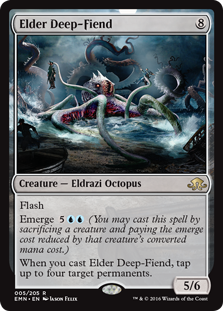 The deck seemed fun, and I rationalized to myself that having Kozilek's Return to survive the early-game, Tireless Tracker to pull ahead in the mid-game, and an incredible top-end threat in Fiend put me in a solid position to go over the fair decks (of which Standard is almost entirely comprised) without first losing to the aggro decks.
The deck seemed fun, and I rationalized to myself that having Kozilek's Return to survive the early-game, Tireless Tracker to pull ahead in the mid-game, and an incredible top-end threat in Fiend put me in a solid position to go over the fair decks (of which Standard is almost entirely comprised) without first losing to the aggro decks.
I gave up on that deck for a couple of reasons. First, it was a little too synergy-oriented for my taste; without the admittedly weak Vessel of Nascency, Temur Emerge often had trouble turning on delirium. A friend I asked for advice told me the deck “needed x and y to come together” before succeeding, and he was right. Second, I realized it was suicide to bring a brew (and an untuned one, at that) to a competitive tournament in a relatively solved format that I’d never played. The best decks are established in Standard, and plenty has been written about them. I decided it was wiser to do my homework and then pick the deck I thought had the best shot of putting me into Day 2.
Back to Black
That deck was Mono-Black Zombies. Most of the top players agree Zombies is the deck to beat this weekend, meaning I’ll have a target over my head. That doesn’t bother me so much as long as I’m playing something competent that I feel okay about. The deck’s apparent grinding and aggressive capabilities appeal to the Spike in me, and you only have to tap a few zombies to Cryptbreaker once to be hooked. Gerry Thompson’s excellent article on the deck gave me an idea of how to sideboard, and a couple of test matches later, I was off to the races.
Modern: Colorless Eldrazi Stompy
This choice should come as a surprise to exactly no-one. After all, I said just last week I’d be playing it! I still made one small change to my configuration:
Colorless Eldrazi Stompy, by Jordan Boisvert
That change was to swap out the singleton mainboard Relic of Progenitus for a Ratchet Bomb. I liked Relic as a hedge against Death’s Shadow, but that matchup is already quite good pre-board thanks to Chalice of the Void. The rest of the time, Relic can sometimes brick later in the game with a Chalice on one, since opponents are unlikely to remove the lock effect before sideboarding. Relic is also dead versus Eldrazi Tron, another matchup I wanted to hedge against—Bomb shines there while also boasting utility against Shadow and many other decks, including Affinity.
Speaking of Affinity, I expect it to perform very well this weekend despite its success at GP Las Vegas two weeks ago. The Invitational crowd is likely to be aware of that deck’s cyclical metagame positioning, and I bet many will try to next-level the competition by sleeving up such an obviously “unsafe” choice.
Stompy in the Metagame
Let’s tackle the deck’s positioning more explicitly. Honestly, I love my chances with Colorless Eldrazi Stompy. I have the intimate knowledge of the deck necessary for success in Modern, it’s a rogue strategy I don’t think opponents will be prepared to beat, and my win rates are superb across the board. Death’s Shadow has all but taken care of GR Valakut, and I believe Death & Taxes/Hatebears/Counters Company will edge out Bant Spirits.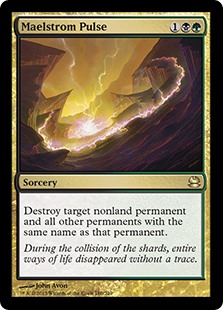
Those are the deck’s two worst matchups. Beyond that, Tarmogoyf, Ancient Grudge, and Maelstrom Pulse made Jund Shadow a harder matchup than Grixis, and the Traverse build has mostly died out by now.
While Eldrazi Tron can be swingy depending on who draws more Temples, I’m also comfortable with my matchup there and wouldn’t mind facing the deck a couple times this weekend. Ideally, though, I’d pair with the rest of the field, which I think will have a very hard time winning through our many angles of attack: Relic shuts down graveyard strategies, Chalice halts opponents too focused on casting one-drops, Thought-Knot Seer and Eldrazi Mimic hassle combo, Scourge lets us “go Dredge” against attrition strategies, and our 13-card post-board removal suite keeps creature decks off their win conditions long enough for Reality Smasher to stick and close out the game.
But What About Eldrazi Tron?
I actually think Colorless Eldrazi Stompy is just a better version of Eldrazi Tron, which is itself one of the strongest decks in Modern. It’s not like I’m bringing a totally rogue deck like Temur Delver to the Invitational; we share plenty of cards with the reigning colorless king. The reason people aren’t playing this deck? They haven’t caught on.
Comparing the two decks, we see that Colorless Eldrazi Stompy has a lower curve, meaning it misses out on cards like Karn Liberated and All is Dust. But since it kills opponents much faster, it doesn’t need those late-game cards. Simian Spirit Guide makes Chalice of the Void all the more potent in our deck than in Eldrazi Tron, in addition to helping buff our openers.
These openers form the other major draw to Stompy. Thanks to Serum Powder and Gemstone Caverns, we don’t have to durdle around with Expedition Map before casting huge guys. Rather, we have more reliable access to fast mana early on, like Bant Eldrazi. Unlike Bant, though, we’re not praying that our mana dork sticks or hoping to open certain colors to get there.
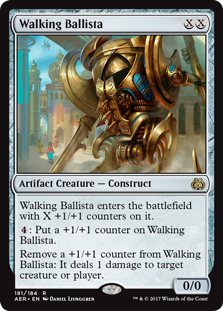 So what does Tron have over Stompy? The big one here is Walking Ballista. Even when cast “fairly” for x = 3 or similar, Ballista is a tremendously versatile card, and one of the major draws to Eldrazi Tron. Of course, the aggro decks it typically dismantles already fold to our removal suite, so Ballista’s true potential lies in its occasional paring with Basilisk Collar. Since Collar is never run as more than a two-of in Eldrazi Tron (and frequently only earns itself a single slot, in the sideboard), I don’t think that’s a particularly alluring reason to run Tron lands over creature lands.
So what does Tron have over Stompy? The big one here is Walking Ballista. Even when cast “fairly” for x = 3 or similar, Ballista is a tremendously versatile card, and one of the major draws to Eldrazi Tron. Of course, the aggro decks it typically dismantles already fold to our removal suite, so Ballista’s true potential lies in its occasional paring with Basilisk Collar. Since Collar is never run as more than a two-of in Eldrazi Tron (and frequently only earns itself a single slot, in the sideboard), I don’t think that’s a particularly alluring reason to run Tron lands over creature lands.
Going back to Colorless Eldrazi Stompy, we also pack a backbreaking combination in our 75: Scourge plus Relic. This pairing makes it impossible for grindy decks to actually grind us out, forcing them into an aggressive role immediately if they want to beat us at all. Even then, they’ll have to defeat us through an unending stream of Wild Nacatls. And I’ve found it more common that opponents fail to realize the role they must take to win, and instead start Bolting and Pushing Scourge to protect their life points. Not once has this strategy worked against Scourge plus Relic, and although I expect my Invitational opponents to be significantly better than those players I duel with on a daily basis, I’d be surprised if nobody made that mistake this weekend.
Shooting for a Pass
For me, Magic is a game about learning. Learning which cards to add or cut; how to sequence plays better in a given scenario; what to play around or towards depending on the format. There’s even learning to be done out-of-game, as I was fortunate to discover this month. Wish me luck this weekend (or tune in on stream now) and I’ll touch base with you again next Friday!




